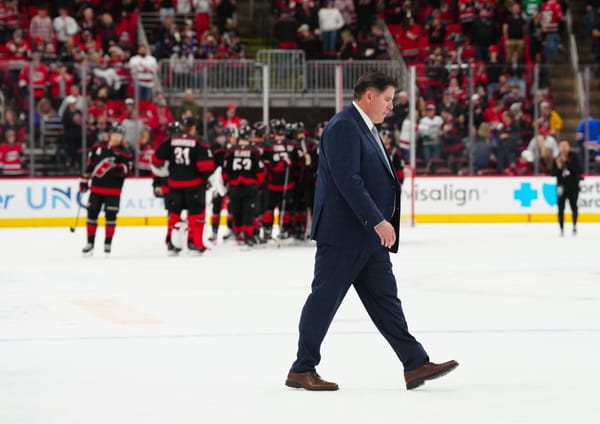What Could A Pavel Buchnevich Extension Look Like?
Buchnevich had a solid case heading into this season, and his hot start certainly makes things more interesting.
Pavel Buchnevich has had a fine start to his 2020-21 season, and it is coming in the final year of a two-year deal in which he’s currently making $3.25 million.
In theory, an extension for Buchnevich shouldn’t be all that difficult, as there have been many comparable deals made with players in his cohort. These include Anthony Mantha, Oliver Bjorkstrand, and Josh Anderson as some recent comparables. But the Rangers’ financial situation, their prospects on the wing, and what Buchnevich could be looking to do make things complicated.
With that said, what could an extension look like? The Rangers won’t be able to formally tender him an offer until March 12, as that is the first time teams can attempt to sign players in the final year of their contract to an extension. Had the season started normally, any negotiations would have been fair game as of January 1.
Heading into this season, Pavel Buchnevich had the following stats on his resume per Evolving-Hockey:
- 27.3 Goals Above Replacement
- 59-88-147 in 247 games played (0.60 points per game)
- 49.77 xGF%
- 52.57 GF%
- 48.51 CF%/
According to Hockey Viz, here’s an estimation of Buchnevich’s ability 5v5 in both ends of the ice.
My initial gut instinct for Buchnevich given his production, age, and comparable deals signed was 5 years at $5.5 million dollars a season. The question though; would that be a good deal for the Rangers? Stay tuned to fine out... or scroll to the bottom if you can’t wait.
The first deal we will look at is Anthony Mantha’s.
Another potential contract to keep in mind for Buchnevich.
— Tom Urtz Jr. (@TomUrtzJr) November 3, 2020
Mantha is 26 with 84-89-173 in 260GP (.67 P/GP)
Buch turns 26 in April and sitting at 59-88-147 in 246GP (.60 P/GP)
In terms of P/GP progression last three years
AM: .60, .72, *.88 - 43GP
PB: .58, .59, .68 https://t.co/OBCTvN57A0
In Mantha’s case, he’s had a higher output, and was signing his deal coming of a season in which he tallied .88 points per game. The deal he signed was at $5.7 million for four years (two RFA years & two UFA years), and I felt this deal represented a good ceiling. Meaning this would be a contract that would serve as a way for the Rangers to push Buchnevich’s offer against.
Dom Luszczyszyn at The Athletic found that Mantha’s deal was a real bargain for the Red Wings, and here’s how it rates out on a yearly basis according to his GSVA (Game Score Value Added) model.
Mantha’s value was significantly higher in Dom’s model vs. what he actually got paid, and the Wings came out with a surplus value of +$3.2 million a season.
Evolving-Hockey also does annual contract projections, and they determined the most likely contract for Mantha would be four years at $6,536,000.
Then there was the Oliver Bjorkstrand deal that came in at $5.4 million. I had some more thoughts on base level numbers considering that is probably want most players use in negotiation, but more context was needed upon further inspection.
Bjorkstand: 246 GP | 65-68-133 (0.54 P/GP) age 26 in April
— Tom Urtz Jr. (@TomUrtzJr) January 6, 2021
Buchnevich: 247 GP | 59-88-147 (0.60 P/GP) age 26 in April https://t.co/xYyDhWaWJz
The main difference here is Buch is at 15:18 ATOI for career where Bjorkstrand is at 14:28. Worth mentioning for context.
— Tom Urtz Jr. (@TomUrtzJr) January 6, 2021
And if you just count ES numbers, OB has slight edge
OB - 56-59-115
PB - 42-64-106
Once again, Dom had a visual showing how great of a deal it was, and it provides some context for what Buchnevich could/should get.
His model suggested that Bjorkstrand’s market value was at $8 million a season, and the Blue Jackets are getting him at $5.4 million for five years once his extension kicks in at the start of the 2021-22 season.
Evolving-Hockey had Bjorkstand at $5,177,000 for four years, and their five-year number was $5,406,000 which is just $6,000 than he actually got.
Lastly there’s Josh Anderson, who was an RFA and signed after being deal from the Blue Jackets to the Montreal Canadiens. He signed a seven-year deal at $5.5 million a year which was a massive gamble to take on a player who had just 115 points in 267 games (0.43 points per game), and is coming of a significant injury.
He never got a fancy card, or I just couldn’t find it, but Evolving-Hockey had the most likely deal for him being two years at $2,786,000. On a seven-year deal, their projected figure was $4,429,000.
For the sake of being consistent with pictures, here’s what his overall impact was at the time of the signing via Hockey Viz.
His contract may be a bit of an outlier with Montreal acquiring him and subsequently signing him for his potential upside, but at the very least I would expect Buchnevich to at least try and match the AAV of $5.5 million.
So with all that said, how do all stack up, and what deal would make sense for New York?
According to Evolving-Hockey, here is how each player stacked up in Goals and Wins Above replacement without including stats from this season.
- Oliver Bjorkstrand - 246 GP | 36.6 GAR & 6.8 WAR | $5.4 million x 4 years
- Anthony Mantha - 260 GP | 33.1 GAR & 6.0 WAR | $5.7 million x 4 years
- Pavel Buchnevich - 247 GP | 27.3 GAR & 5 WAR | $3.25 million, one year left
- Josh Anderson - 267 GP | 21.6 GAR & 4.1 WAR | $5.5 million x 7 years/
With that said, here’s how my hypothetical Buchnevich deal suggested at the beginning of the article grades out.
My suggestion of a $5.5 million a year deal for five years would be $0.4 million more a year than he’s currently worth according to Dom’s model over the life of the contract. His current market value, per the model, is $5.1 million. So while it is still more than he’s worth —according to Dom’s numbers— I wasn’t completely off base. Evolving-Hockey thought similarly, as their projection comes in at $5,451,000 for five years. And keep in mind, this doesn’t factor in his start to the season, which if it continues, could bump up his price to fall closer within this range.
Buchnevich, per Dom’s model, is also currently worth 1.4 GSVA. That puts him in top-six territory and he is expected to remain a top-six forward until 2025, and decline steadily over that period. Other tiers for players include elite, top line, top nine, bottom line, and replacement level. An example of an elite player is someone like Artemiy Panarin, who is projected to be worth 4.19 GSVA,
Buchnevich is currently the team’s top line right winger, and is skating with Mika Zibanejad (two years remaining), and Chris Kreider (seven years remaining). Behind him is 2019 No. 2 overall pick Kaapo Kakko, someone the Rangers hope can be a bona fide top line player for the next decade or so.
Looking at the projection for Buchnevich certainly makes things interesting when deciding whether or not to sign him to a long-term deal. While this is a projection — and he certainly could breakout more than anticipated — by and large Buchnevich appears to be what he’ll be at this point, and that’s a 50-point player who is showing he’s a better defensive player than he’s been given credit for.
Stanley Cup contenders need players like Buchnevich, but it all comes down to cost. Because having him as a second or third-line winger could provide tremendous value to the team’s lineup as long as he isn’t overpaid. Personally speaking, it is no secret that I feel Buchnevich is someone who certainly helps the team’s long term Stanley Cup odds.
This presents a challenge for New York, because while they could try and sign him for three years (one RFA year, two UFA years which takes him to age 29) and bridge the gap until Kakko and Vitali Kravtsov are ready to takeover, Buchnevich may want some security. And given his production and impact, he’s within reason to ask for it.
In many respects, while in normal times extending Buchnevich would have made sense, he may not be looking to sign in March when he’s available to do so. He may ultimately choose to bet on himself, and put himself in a position to force the Rangers to make a tough choice. He has one RFA year left at the end of his contract, and that means the Rangers will need to make a definitive decision. This is the same situation they were in with Kevin Hayes, and ultimately we saw how that played out. Such a decision would have been much easier had the team not re-signed Kreider at $6.5 million for seven years or if they weren’t dealing with a flat cap.
The Rangers’ Buchnevich decision could be influenced by how Kakko plays in his second season, and how Kravtsov finishes his KHL season with there being the potential he gets in some NHL games if Traktor misses the playoffs.
Although this story was primarily focused on his play prior to this year, his start to this year obviously could have a sizable impact on negotiations. Not only has he played well, but he’s been one the the team’s most marketed players, as Captain Happy has an infectious personality and is quite popular with his teammates. Obviously it is a business, but given Buchnevich is really close with the team’s best player (Artemiy Panarin) and the goalie of the future (Igor Shesterkin), odds are the team will want to find a way to keep him around.
It makes your heart happy. pic.twitter.com/WGuxEzW8lW
— New York Rangers (@NYRangers) February 5, 2021
Pavel Buchnevich has been a solid player for the Rangers, and is in a position to increase his value. There’s certainly some major merits to re-signing him, and there is by far enough information available to work out a new deal that makes sense for both sides.
Stats via Evolving-Hockey unless otherwise noted.





